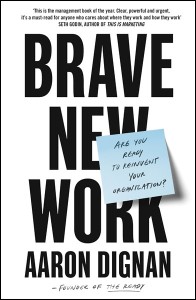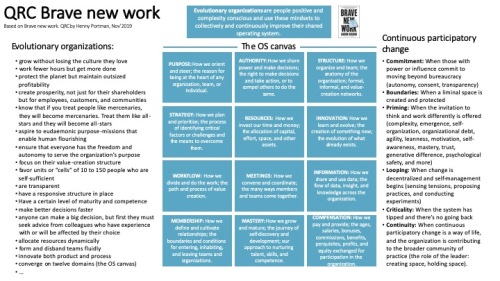 In his book Brave new work, Aaron Dignan shows how he views evolutionary (agile) organizations and what you can do to become a more agile organization.
In his book Brave new work, Aaron Dignan shows how he views evolutionary (agile) organizations and what you can do to become a more agile organization.
The book is made up of three parts. The first part – The future of our work shows how our work has changed as a result of technological progress and on the other hand that for many organizations this does not apply to management. An organization chart of an organization from 100 years ago is still comparable with many organizations of today. But there are also organizations that do it completely different. The illusion of control is exchanged for something much better. The author calls these pioneering organizations evolutionary organizations. Evolutionary organizations are people positive and complexity conscious and use these mindsets to collectively and continuously improve their shared operating system (how the organization works).
Based on comments throughout the book, evolutionary organizations can be characterized as follows:
- grow without losing the culture they love
- work fewer hours but get more done
- protect the planet but maintain outsized profitability
- create prosperity, not just for their shareholders but for employees, customers, and communities
- know that if you treat people like mercenaries, they will become mercenaries. Treat them like all-stars and they will become all-stars
- aspire to eudaemonic purpose-missions that enable human flourishing
- ensure that everyone has the freedom and autonomy to serve the organization’s purpose
- focus on their value-creation structure
- favor units or “cells” of 10 to 150 people who are self-sufficient
- are transparent
- have a responsive structure in place
- Have a certain level of maturity and competence
- make better decisions faster
- anyone can make a big decision, but first they must seek advice from colleagues who have experience with or will be affected by their choice
- allocate resources dynamically
- form and disband teams fluidly
- innovate both product and process
- converge on twelve domains (the OS canvas)
This last point, evolutionary organizations converge on twelve domains, is elaborated in part two – The operating system. These twelve domains form the Operating System Canvas (OS canvas).
The OS Canvas:
- PURPOSE: How we orient and steer; the reason for being at the heart of any organization, team, or individual.
- AUTHORITY: How we share power and make decisions; the right to make decisions and take action, or to compel others to do the same.
- STRUCTURE: How we organize and team; the anatomy of the organization; formal, informal, and value-creation networks.
- STRATEGY: How we plan and prioritize; the process of identifying critical factors or challenges and the means to overcome them.
- RESOURCES: How we invest our time and money; the allocation of capital, effort, space, and other assets.
- INNOVATION: How we learn and evolve; the creation of something new; the evolution of what already exists.
- WORKFLOW: How we divide and do the work; the path and process of value creation.
- MEETINGS: How we convene and coordinate; the many ways members and teams come together.
- INFORMATION: How we share and use data; the flow of data, insight, and knowledge across the organization.
- MEMBERSHIP: How we define and cultivate relationships; the boundaries and conditions for entering, inhabiting, and leaving teams and organizations.
- MASTERY: How we grow and mature; the journey of self-discovery and development; our approach to nurturing talent, skills, and competence.
- COMPENSATION: How we pay and provide; the ages, salaries, bonuses, commissions, benefits, perquisites, profits, and equity exchanged for participation in the organization.
 To download: QRC (Brave new work EN, 191101) v1.0
To download: QRC (Brave new work EN, 191101) v1.0
Each domain of the OS canvas is further elaborated in its own chapter. You get an extensive explanation based on concrete examples. Many to be applied techniques and step-by-step plans are provided too. In addition, you will receive for each domain a questionnaire that can be put to the entire organization or to individual teams. The canvas can provoke incredible conversations and powerful stories to determine which elements in your culture need to be strengthened and what needs to be done differently. Each chapter is concluded with an explanation of the two mindsets. How can you incorporate a people positive and complexity conscious mindset in the domain described?
In the third part – The change, the central question is how an operating system transformation works. This is based on a continuous participatory change. Within this continuous participatory change are six important patterns (Do not mistake these for steps. They’re more akin to thresholds):
- Commitment: When those with power or influence commit to moving beyond bureaucracy (autonomy, consent, transparency)
- Boundaries: When a liminal space is created and protected
- Priming: When the invitation to think and work differently is offered (complexity, emergence, self-organization, organizational debt, agility, leanness, motivation, self-awareness, mastery, trust, generative difference, psychological safety, and more)
- Looping: When change is decentralized and self-management begins (sensing tensions, proposing practices, and conducting experiments)
- Criticality: When the system has tipped and there’s no going back
- Continuity: When continuous participatory change is a way of life, and the organization is contributing to the broader community of practice (the role of the leader: creating space, holding space).
Conclusion: A book that shows what it means to achieve more business agility without getting bogged down in a description of implementing a (scaling) agile framework, because that alone won’t get you there. A must read for managers, with many practical tools to get started.
To order: Brave New Work
Youtube: Talk at Google: We were joined by Aaron Dignan, the founder of The Ready, an organization design and transformation firm, and author of “Brave New Work” to discuss better ways of working and how to ignite the energy in an organization, building a company that runs itself.
Zie verder mijn blog voor een recensie van de Nederlandse uitgave.
















Pingback: Overview of my year 2019 book reviews | Henny Portman's Blog
Pingback: Quick Reference Cards in 2019 | Henny Portman's Blog